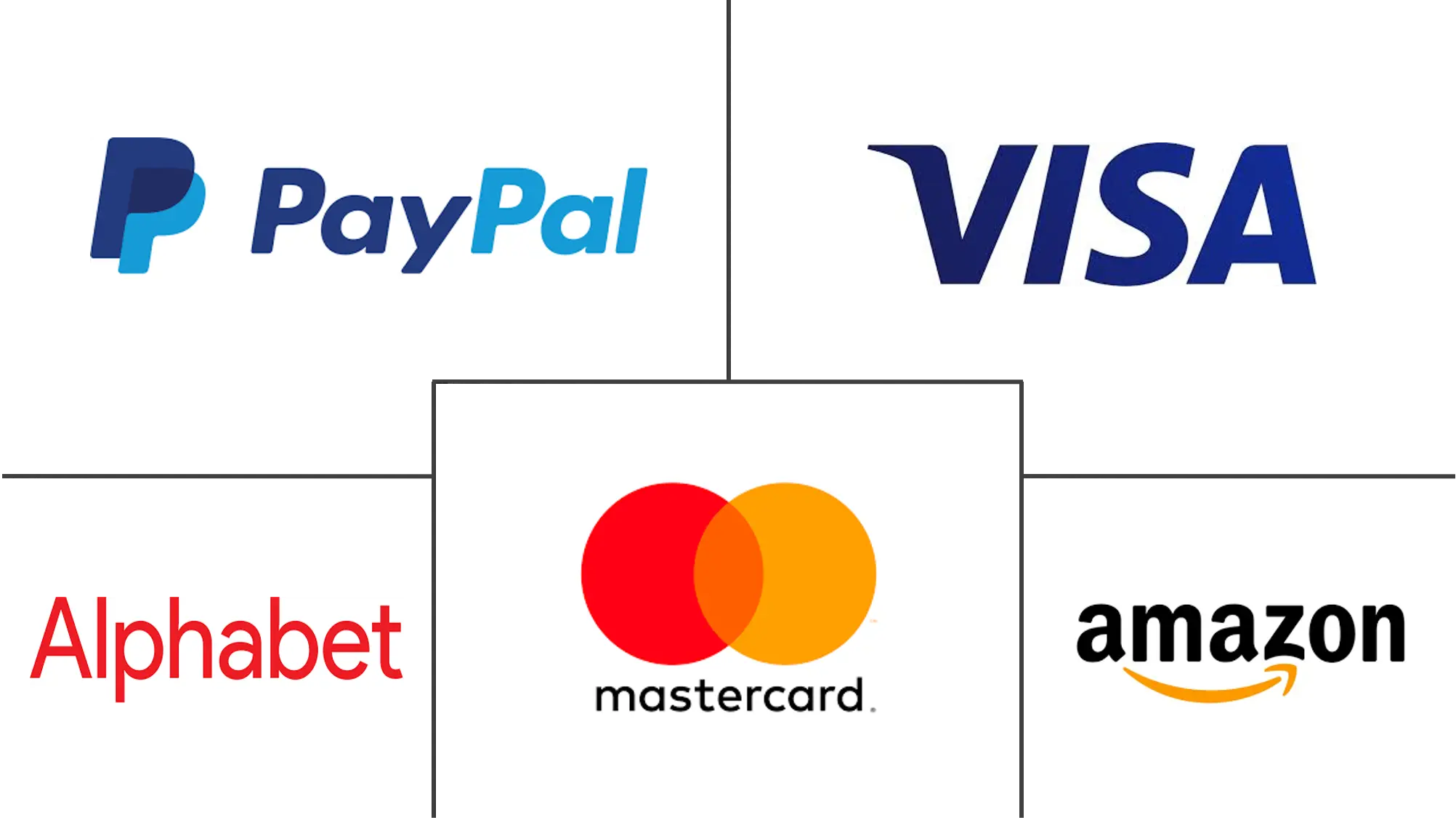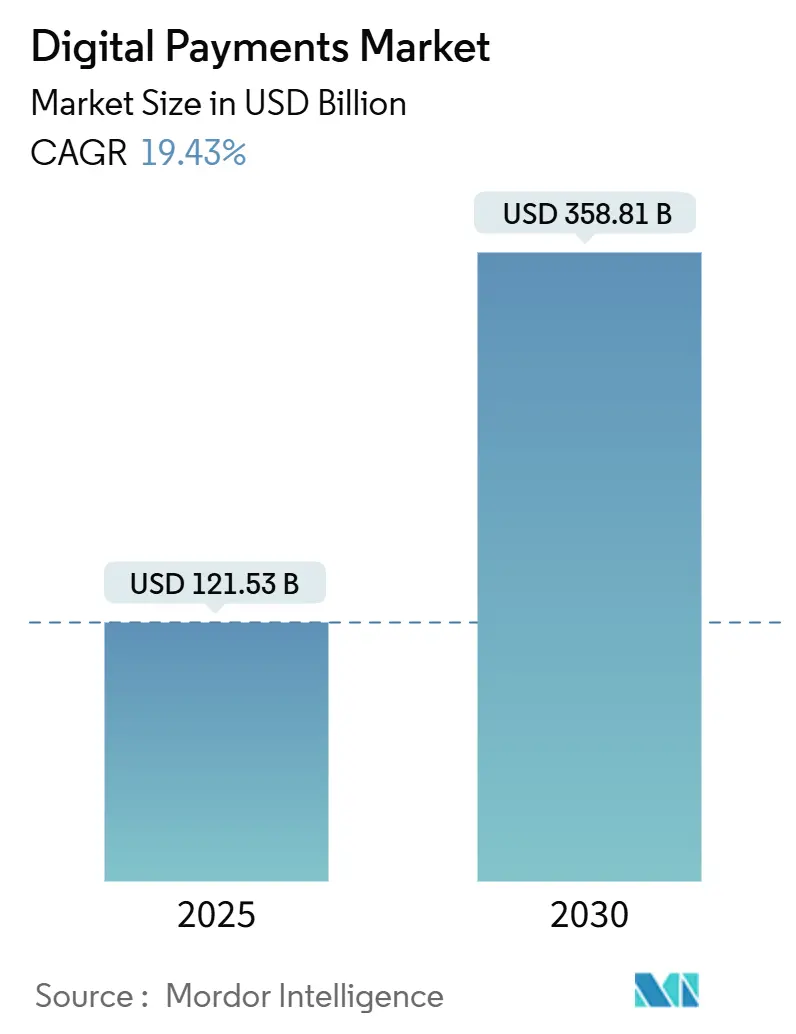
Digital Payments Market Analysis by Mordor Intelligence
The digital payments market size is estimated at USD 121.53 billion in 2025 and is on course to reach USD 358.81 billion by 2030, reflecting a 19.43% CAGR for the 2025-2030 period. This strong outlook is shaped by synchronized regulation across major economies, the spread of interoperable payment rails, and rising demand for seamless cross-border commerce. Interactions between large card networks and alternative payment methods are redefining competitive boundaries, while artificial intelligence raises the bar for fraud prevention and real-time decisioning. Strategic opportunities arise where mature markets provide volume stability and emerging regions deliver rapid expansion, encouraging processors to balance investments in efficiency with moves into high-growth corridors. Regulatory clarity around tokenization and instant payments compresses fragmentation costs, rewarding early movers that align product roadmaps with new compliance templates.
Key Report Takeaways
- By mode of payment, point-of-sale led with 57.2% of digital payments market share in 2024, while online and remote payments are forecast to advance at an 18.6% CAGR through 2030.
- By component, solutions held 63.4% revenue in 2024; services are projected to expand at a 20.4% CAGR to 2030.
- By end-user industry, retail and e-commerce accounted for 34.1% of the digital payments market size in 2024, whereas healthcare is set to grow at a 21.7% CAGR through 2030.
- By enterprise size, large enterprises captured 68.8% of revenue in 2024, but small and medium enterprises will post the fastest growth at a 22.9% CAGR to 2030.
- By geography, North America commanded 38.3% revenue in 2024; Asia-Pacific is forecast to register a 17.3% CAGR through 2030.
Global Digital Payments Market Trends and Insights
Drivers Impact Analysis
| Driver | (~) % Impact on CAGR Forecast | Geographic Relevance | Impact Timeline |
|---|---|---|---|
| Increasing Surge in QR-code payments across Southeast Asia | +3.2% | ASEAN core, spill-over to South Asia | Medium term (2-4 years) |
| EU tokenisation mandates boosting the online security | +2.8% | Europe primary, global adoption following | Long term (≥ 4 years) |
| Cross-border e-commerce demand for APMs in South America | +2.1% | South America, extension to LATAM | Medium term (2-4 years) |
| Increase in Gen-Z BNPL uptake adoption in North America | +1.9% | North America, spreading to developed markets | Short term (≤ 2 years) |
| Instant payroll disbursement schemes in GCC | +1.4% | GCC states, potential MEA expansion | Medium term (2-4 years) |
| Source: Mordor Intelligence | |||
QR-Code Payment Standardization Drives Southeast Asian Integration
Standardized QR infrastructure is scaling rapidly, as Indonesia’s QRIS processed 779 million transactions worth IDR 82 trillion (USD 5.4 billion) in Q4 2024, connecting 55 million users and 36 million merchants. [1]Katadata Research, “QRIS Catapults Digital Transactions in Indonesia,” katadata.co.id Cross-border linkage with Thailand sets a template that could trim remittance costs by up to 50%, positioning ASEAN for integrated payment corridors. Government leadership lets micro-enterprises accept digital payments without credit histories, accelerating financial inclusion.
EU Tokenization Mandates Establish Global Security Standards
The Markets in Crypto-Assets regulation took effect in December 2024 and obliges tokenization for digital assets, influencing processors beyond Europe. Visa’s issuance of 1 billion tokens across Asia-Pacific shows how compliance builds scalable security layers that improve user experience. Reserve-backed token rules shape global stablecoin design, while European Central Bank guidance on a digital euro adds interoperability checkpoints.[2]European Central Bank, “Digital Euro Rulebook Preparation,” ecb.europa.eu
Cross-Border E-Commerce Fuels Alternative Payment Method Adoption
Latin America’s digital commerce is tracking toward USD 950 billion by 2026, which drives preference for instant schemes like Brazil’s PIX and Mexico’s CoDi. Regional orchestrators such as Kushki processed 140 million transactions valued at USD 15 billion in 2023, aggregating local rails into single APIs for global merchants. Central-bank-backed fast payment systems across 15 countries set the stage for cost-efficient remittances.
Gen-Z BNPL Adoption Reshapes North American Credit Markets
Buy Now Pay Later penetrated essential services in 2024, with usage in utilities outpacing credit cards among younger cohorts. Kansas City Federal Reserve research shows BNPL users face distinct liquidity timing constraints rather than credit access gaps, revealing new credit scoring considerations. Merchants embed BNPL to lift conversion while processors refine risk models to manage regulatory scrutiny.
Restraints Impact Analysis
| Restraint | (~) % Impact on CAGR Forecast | Geographic Relevance | Impact Timeline |
|---|---|---|---|
| Fragmented KYC rules in the Caribbeans challenges the market | -1.8% | Caribbean states, affecting cross-border flows | Long term (≥ 4 years) |
| Increase adoption of Cash preference in rural Africa | -2.3% | Sub-Saharan Africa rural areas | Medium term (2-4 years) |
| Rising CNP fraud costs for mid-tier merchants | -2.7% | Global, concentrated in e-commerce segments | Short term (≤ 2 years) |
| Source: Mordor Intelligence | |||
Fragmented Caribbean KYC Rules Create Friction
Divergent anti-money-laundering standards across Caribbean nations compel processors to run multiple compliance programs, raising cost-to-serve and slowing regional integration.
Rural Africa Cash Preference Limits Digital Penetration
Mobile money transactions reached USD 1.68 trillion in 2024, yet rural reliance on cash persists due to patchy infrastructure and a 21% gender gap in account ownership. [3]: GSMA, “State of the Industry Report on Mobile Money 2024,” gsma.com Liquidity constraints and limited network uptime deter consistent digital usage, stalling deeper market reach.
Segment Analysis
By Mode of Payment: POS Dominance Faces Digital Disruption
Point-of-sale channels accounted for 57.2% of the digital payments market size in 2024, but online and remote options are compounding at an 18.6% CAGR through 2030. This trajectory reflects European mobile payment value climbing from EUR 4 billion (USD 4.4 billion) in 2017 to EUR 195 billion (USD 212.6 billion) in 2024, validating policy-led adoption. Contactless preferences, cited by 49.1% of travelers wanting permanent mobile payments, keep pushing merchants to upgrade acceptance infrastructure. The spread of instant payment rails blurs channel lines, so providers integrate unified orchestration that covers in-store, web, and in-app flows. Real-time authorization with AI-driven risk engines gives POS vendors a differentiator as remote volume migrates to wallets and pay-by-bank.
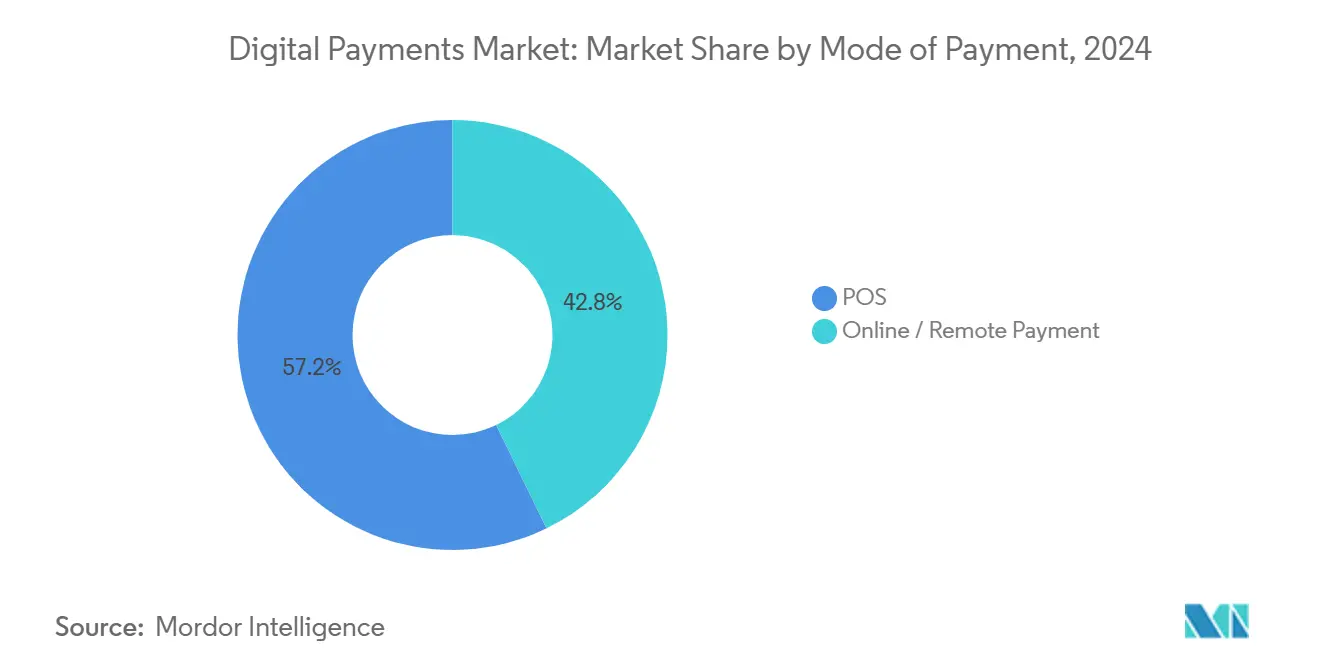
Note: Segment shares of all individual segments available upon report purchase
By Component: Services Growth Outpaces Solutions Development
Solutions commanded 63.4% revenue in 2024, whereas services are advancing at a 20.4% CAGR, showing that implementation expertise now drives wallet share. Fiserv repositioned its Clover stack from hardware to commerce enablement, delivering double-digit top-line expansion and proof that services deepen engagement. Stripe processed USD 1.4 trillion in 2024, with developer-centric onboarding underscoring how orchestration services capture switching merchants. Advisory and compliance services are in demand as MiCA, instant payment mandates, and ISO 20022 migration raise complexity. Significant cross-border opportunity exists for firms that bundle settlement, FX, and tax reporting in white-label APIs.
By End-User Industry: Healthcare Leads Digital Transformation
Retail and e-commerce retained 34.1% revenue in 2024, but healthcare is pacing the field at a 21.7% CAGR through 2030, supported by electronic health record integration and supply-chain automation. Digital billing eliminates paper checks and improves cash flow, raising patient satisfaction. Field studies in Senegal attest to 88.9% satisfaction among health workers using digital payouts, reinforcing adoption momentum. Travel, media, and public utilities follow closely as consumer experience and regulatory reporting demands converge on unified checkout experiences.

Note: Segment shares of all individual segments available upon report purchase
By Enterprise Size: SMEs Drive Adoption Through Embedded Finance
Large enterprises generated 68.8% revenue in 2024, yet SMEs are expanding at a 22.9% CAGR, propelled by plug-and-play embedded finance stacks that compress time to market. Square maintains leadership in micro-merchant acquiring, though Fiserv gains share through Clover upgrades and Payfare integration. API-first suppliers deliver modular payments, lending, and treasury functions that map to fast-growing platform ecosystems. Regulatory sandboxes across multiple jurisdictions let SMEs pilot tokenized settlement with limited compliance risk.
Geography Analysis
North America held 38.3% revenue in 2024, underpinned by card network dominance and the rollout of FedNow, yet competitive pressure escalates as Asia-Pacific posts a 17.3% CAGR through 2030. The emergence of stablecoin initiatives backed by major U.S. banks signals that digital currency rails may cut settlement friction across the Canada-United States-Mexico corridor, fostering new service models.
Asia-Pacific is the primary growth engine, powered by China’s digital yuan pilots, India’s UPI expansion, and the regional impact of QRIS integration. Indonesia alone processed USD 5.4 billion in QR payments in Q4 2024, confirming the network effect of standardized codes. Local processors form alliances with global gateways to bridge compliance gaps, while Japan’s direct acquiring reforms encourage foreign PSP entry.
Europe leverages regulatory leadership. MiCA removes fragmentation, and the instant payments regulation effective January 2025 forces banks to offer round-the-clock euro transfers, shaping processor investment priorities. Harmonized token standards encourage cross-border service design, while niche markets in the Nordics and Baltics continue to pilot open-banking-based pay-by-account checkouts.
South America, the Middle East, and Africa present diverse adoption curves. Brazil’s PIX, Mexico’s CoDi, and GCC instant payroll schemes each demonstrate how state-backed rails shorten settlement cycles and lower merchant costs. Mobile money agents across Africa handled USD 1.68 trillion in 2024, yet rural gaps remain due to cash bias and network reliability challenges.
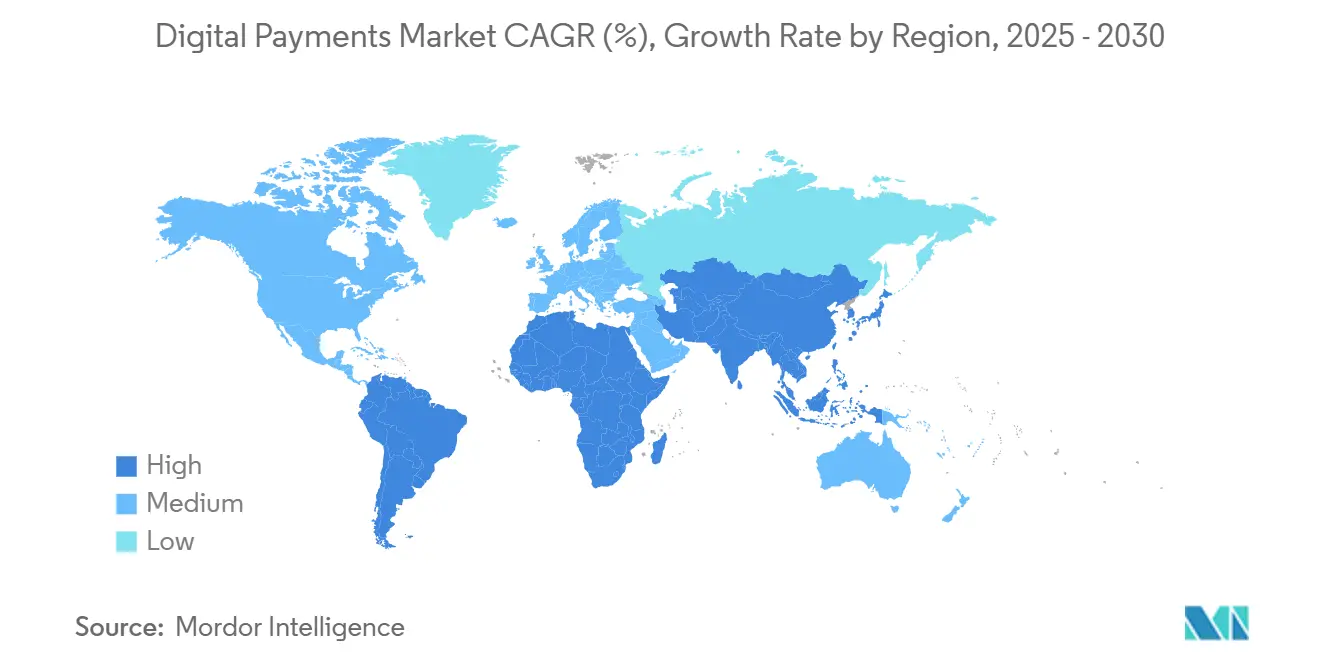
Competitive Landscape
The digital payments market features rising moderate concentration in capabilities. Visa processed more than USD 13 trillion in 2024, maintaining a 69.3% adjusted operating margin that funds investments in network tokenization and AI fraud analytics. PayPal served 434 million active users and moved USD 1.68 trillion, translating North American scale into European wallet competition and Brazilian platform growth.
Stripe’s 17.15% share of the USD 173.38 billion global processing pool showcases the pull of developer-first APIs, while its recent crypto payment relaunch aligns with merchant appetite for lower FX spreads. Adyen’s Fastlane checkout uses PayPal Vaulting to cut guest-checkout friction by 80%, illustrating partnership models that enlarge addressable volume.
Consolidation is picking up. Fiserv’s Payfare acquisition broadens embedded finance breadth, targeting a USD 5.5 billion free-cash-flow pool and aiming for double-digit organic growth in 2025. A federal court decision allowing third-party in-app payments unlocks a USD 100 billion opportunity for Stripe, PayPal, and Bolt, which are racing to deliver compliant SDKs that improve merchant economics. Machine-learning fraud platforms and tokenized settlement layers are becoming must-have features, lifting barriers for smaller entrants and setting the stage for either niche specialization or acquisition.
Digital Payments Industry Leaders
-
Paypal Holdings Inc.
-
Visa Inc.
-
Mastercard Incorporated (Mastercard)
-
Amazon Payments Inc. (Amazon.com Inc.)
-
Alphabet Inc.
- *Disclaimer: Major Players sorted in no particular order
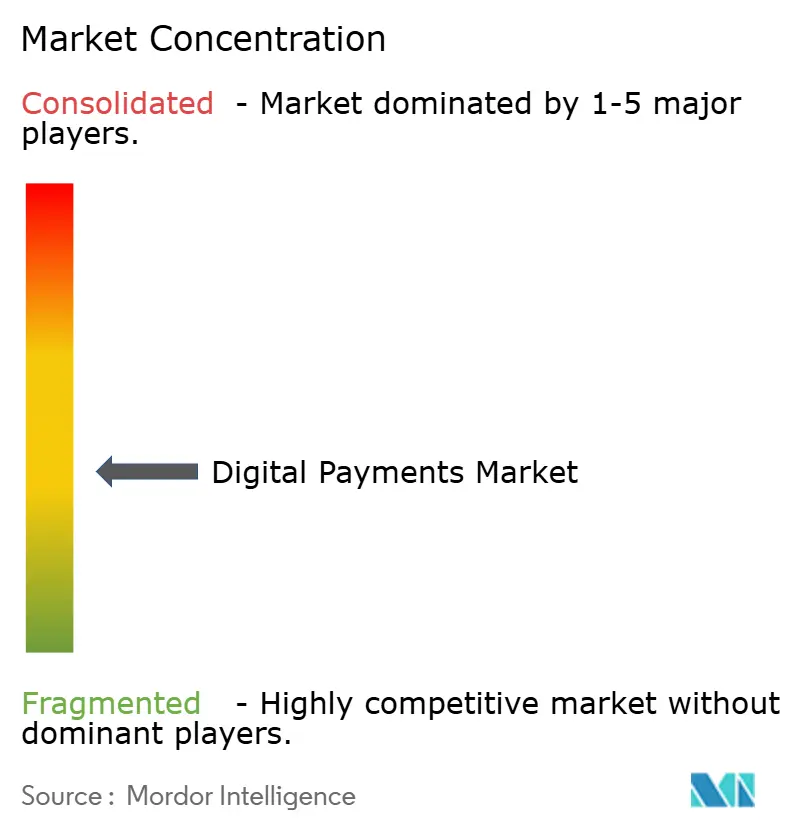
Recent Industry Developments
- June 2025: Apple, Google, Airbnb, and X opened talks with crypto firms to embed stablecoin payments, seeking lower cross-border fees after stablecoins processed USD 27.6 trillion in 2024. The move signals big-tech intent to control settlement costs and data flows.
- May 2025: Fiserv expanded Commerce Hub and closed its Payfare acquisition, targeting embedded finance growth and USD 5.5 billion in free cash flow with a 10-12% organic revenue goal. Strategy centers on bundling payroll cards and SMB acquiring under one cloud stack.
- May 2025: The European Central Bank released technical guidance for the digital euro, outlining interface standards that PSPs must adopt to access issuance infrastructure. Vendors are adjusting core systems to comply ahead of pilot rollouts.
- April 2025: PayPal introduced new wallet features in Germany to compete with Apple Pay and Google Pay, leveraging its USD 31.8 billion 2024 revenue base to deepen European penetration.
- March 2025: Fitch Ratings reaffirmed PayPal’s long-term rating at A- but noted that profit growth will moderate to mid-single digits as competitive intensity rises.
- January 2025: The European Union’s instant payments regulation entered into force, obligating euro-area PSPs to receive instant transfers and to send them by Oct 2025.
Research Methodology Framework and Report Scope
Market Definitions and Key Coverage
Our study defines the digital payments market as all consumer-facing transactions settled through online payment gateways, direct debit rails, or mobile point-of-sale readers, where money moves electronically rather than in physical cash. We capture revenues earned by solution vendors and service providers that enable these flows, split by payment mode, component, enterprise size, industry vertical, and region.
Scope exclusion: enterprise-to-enterprise settlement platforms, crypto-asset trading, and purely card-issuing fees lie outside this assessment.
Segmentation Overview
- By Mode of Payment
- Point of Sale (POS)
- Online / Remote Payment
- By Component
- Solutions (Gateway, Processing, Wallet, Fraud, Other)
- Services (Consulting, Integration, Support)
- By Enterprise Size
- Large Enterprises
- Small and Medium Enterprises (SMEs)
- By End-user Industry
- Retail and E-commerce
- Media and Entertainment
- Healthcare
- Hospitality and Travel
- Other Industries (Education, Utilities, Govt.)
- By Geography
- North America
- United States
- Canada
- Mexico
- Europe
- Germany
- United Kingdom
- France
- Nordics
- Rest of Europe
- Asia-Pacific
- China
- India
- Japan
- Rest of Asia-Pacific
- South America
- Brazil
- Argentina
- Rest of South America
- Middle East
- GCC
- Turkey
- Rest of Middle East
- Africa
- South Africa
- Nigeria
- Rest of Africa
- North America
Detailed Research Methodology and Data Validation
Desk Research
We began by mapping the universe of digital payment flows using open datasets such as the BIS Red Book, the World Bank Global Findex, IMF Payment Statistics, and central-bank dashboards from the Federal Reserve and the European Central Bank. Company 10-Ks, investor presentations, and e-commerce association white papers added channel-specific volumes, while paid repositories like D&B Hoovers and Dow Jones Factiva helped our analysts size vendor revenue pools. Public procurement portals and patent libraries (Questel) provided additional visibility into pipeline projects and innovation trends. The sources listed here are illustrative; many other publications were reviewed during evidence gathering and cross-checks.
Primary Research
To validate secondary signals, our team interviewed payment gateway executives, acquirers, fintech founders, and merchant treasurers across North America, Europe, and Asia-Pacific. Short surveys with retail SMEs and healthcare providers clarified adoption rates, transaction mixes, and average service fees, letting us adjust raw desk figures for real-world acceptance gaps.
Market-Sizing & Forecasting
The baseline value is first estimated top-down through a transaction-value reconstruction that links household e-commerce spending, in-store card penetration, and smartphone wallet share. Results are then benchmarked against selective bottom-up lenses (sampled provider revenue × average take-rate, channel checks on monthly active users) to spot over- or under-counts. Key market fingerprints that feed the model include smartphone penetration, contactless card circulation, interchange-fee regulation timelines, real-time payment rail rollout, cross-border e-commerce growth, and fraud-loss ratios. A multivariate regression framework, stress-tested under conservative, base, and optimistic scenarios, projects demand through 2030. Coefficients are aligned with consensus views gathered during expert calls. Where granular supplier data were sparse, we interpolated using region-specific adoption curves and price-volume elasticities.
Data Validation & Update Cycle
Before sign-off, Mordor analysts rerun variance checks against macro payment indicators, flag anomalies, and peer-review each worksheet. Models refresh annually, with mid-cycle updates triggered by material regulatory or technology shifts. Each report is re-read before delivery so clients receive the most current view.
Why Mordor's Digital Payment Baseline Commands Reliability
Published estimates often diverge because firms anchor on different revenue streams, user cohorts, and refresh cadences.
Our disciplined scope and yearly rebuild minimize those inconsistencies.
Benchmark comparison
| Market Size | Anonymized source | Primary gap driver |
|---|---|---|
| USD 121.53 B (2025) | Mordor Intelligence | - |
| USD 170.24 B (2025) | Global Consultancy A | Includes B2B and digital remittance flows; relies solely on vendor revenue disclosures |
| USD 137.04 B (2025) | Industry Analytics B | Excludes mobile POS wallets and uses survey extrapolation without de-duplication |
| USD 130.49 B (2025) | Trade Journal C | Counts upfront software licenses as transaction revenue and locks FX rates to 2023 averages |
Taken together, the comparison shows that Mordor's balanced definition, dual-path modeling, and frequent updates yield a dependable baseline that decision-makers can trace back to clear variables and repeatable steps.
Key Questions Answered in the Report
What is the current value of the digital payments market?
The digital payments market is valued at USD 121.53 billion in 2025, and it is projected to hit USD 358.81 billion by 2030.
Which region is growing fastest in digital payments?
Asia-Pacific leads growth with a 17.3% CAGR through 2030, driven by initiatives such as UPI in India and QRIS in Indonesia.
Why are services outpacing solutions in the sector?
Regulatory complexity and merchant demand for single-API orchestration make implementation and compliance services more valuable than commoditized processing software.
How big is the healthcare opportunity in digital payments?
Healthcare is the fastest-growing end-user segment with a 21.7% CAGR, reflecting integration with electronic health records and supply-chain systems.
How will instant payments regulation in Europe influence global providers?
From January 2025 banks must receive euro instant payments, forcing processors worldwide to upgrade settlement engines to remain interoperable with European clients.
Page last updated on:
